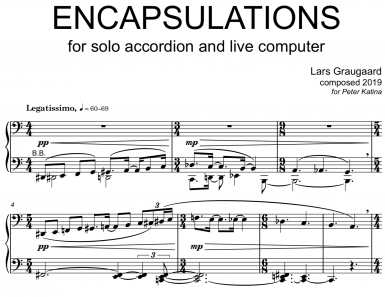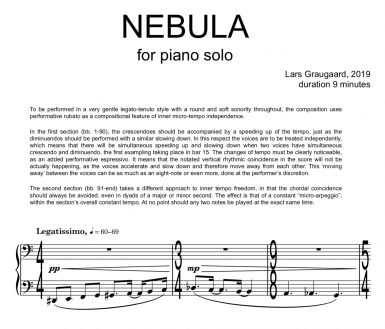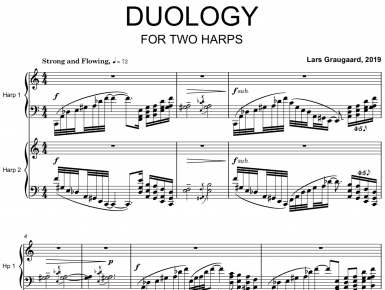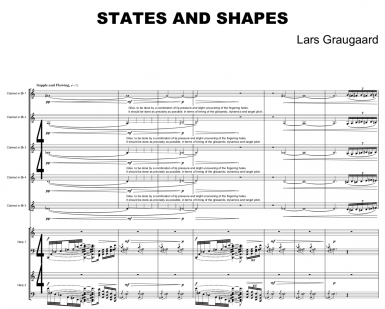-
Encapsulations
accordion solo and live computer (2019)
-
Nebula
piano solo (2019)
-
Duology
two harps (2019)
-
States and Shapes
five clarinets and two harps (2019)
-
Duxipidious
cl, vla, vcl, hp, pno, perc, laptop (2018)
-
Fabule
symphony orchestra; 2,2,2,2/2,2,0,0/timpani/6,5,4,3,2 (2016/2017)
-
Cinco Canciones
harp and voice (2017)
-
Crumble
laptop, electric guitar and drum kit (2017)
-
Slonk
1,1,1,1/1,1,1,0/arpa,pno,2perc/1,1,1,1,1 (2017)
-
Undertow
symphony orchestra; 2,2,2,2/2,2,0,0/timpani/6,5,4,3,2 (2016/2017)
-
Persect
laptop (2016)
-
What Actually Happened
laptop and drum kit (2016)
-
Slow Gist
double-bass and interactive computer (2016)
-
Revolving Circles
four violins and computer electronics (2016)
-
Rife
for laptop and endangered guitar (2015)
-
Invisible
laptop and electric guitar (2016)
-
Americanino
laptop (2014)
-
Ngelo
laptop and electric guitar (2014)
-
Engage and Share
1,1,1,1/1,1,1,0/arpa,pno,1perc/1,1,1,1,1 (2014)
-
Book of Throws
2 fl, cl, hn, trp, pno, 2 perc, vln, vla, vcl, d-b and solo piano (2013)
-
Venus
violin and double-bass solo, electronics and orchestra 2,2,2,2/2,2,0,0/arpa/8,7,5,5,3 (2013)
-
The Yurodny Files
laptop and ensemble (2013)
-
Tompkins
clarinet in Bb and piano (2013)
-
Blind Lemon
1,1,1,1/1,1,1,0/arpa,pno,1perc/1,1,1,1,1 (2013)
-
nvmbr
laptop and electric guitar (2012)
-
Downstream
laptop, flutes and ensemble (2012)
-
Fact Machine
laptop and piano (2012)
-
We Should Have Turned Left Earlier
laptop and ensemble (2012)
-
Layers of Earth
oboe solo, int-comp, 15 percussion (2011/12)
-
Milbank’s Football
2,2,2,2/2,2,0,0/perc/6,5,4,3,2 (2011)
-
Thump
laptop (2011)
-
Three Places
fl, cl, perc, pno, vln, vcl (2011)
-
Red Stuff
laptop (2011)
-
Touchdown
four-handed harp (2011)
-
One Up
laptop and double bass (2011)
-
Walk
8-12 players and interactive computer (2011)
-
Palpitations
piano and interactive computer (2011)
-
Bloom
flute, clarinet and piano (2010/11)
-
Quiet Voice
clarinet and interactive computer (2010)
-
Sparks and Feathers
violin and interactive computer (2010)
-
Defun
fl, cl, vcl, pno, hp, int-comp (2010)
-
Add
laptop (2010)
-
Marsism
laptop (2010)
-
Versus
installation (2009)
-
Psychoacoustic Evergreens
laptop (2009)
-
Life on Mars?
laptop (2009)
-
Sound Shapes
harp and interactive computer (2008)
-
Ubsent Entrards
1,1,1,1/1,1,1,0/pno,perc/2,1,1,1 (2008)
-
Babilu Volati
voice and interactive computer (2008)
-
Tears of Dionysius
reciter, film and sinfonietta ensemble (2001/08)
-
Deep South
b-fl, guit, pno, timp, vln, vcl, int-comp (2007)
-
Thieves
cello and interactive computer (2006)
-
Trenes de Marzo
countertenor and interactive computer (2006)
-
Gestures You Made
oboe and interactive computer (2005/06)
-
Plunge
fl, cl, trb, perc, pno, vla, vcl (2005)
-
Other Planets
violin and accordion (2005)
-
Three Pieces: Before – Projection – After
double-bass and interactive computer (2005)
-
The Sound Glove II
installation (2005)
-
Blue Collusion and Entourage
solo b-cl and fl, ob, hn, mba, vln, vla, vcl, db (2004)
-
Three Etudes for Piano
piano solo (2004)
-
Time Flakes
viola solo (2004)
-
La Quintrala
five singers and interactive computer (2003/04)
-
Donde el Amor te Lleve
choir and harp (2003/04)
-
Membrana Tympanus
soprano and piano (2003/04)
-
Smeared
solo accordion and cl, pno, perc, vln, vla, vcl, d-b (2003)
-
Flocking
recorder quartet and optional vibraphone (2003)
-
Squeeze and Reveal
bass clarinet and piano (2003)
-
Round
guitar solo (2003)
-
Behind Your Hands
accordion and interactive computer (2003)
-
Speak My Mind
tenor recorder and interactive computer (2003)
-
Shattered Glass
fl, cl, pno, vln, vcl (2003)
-
Concealed Behaviours
bass clarinet and interactive computer (2002/03)
-
Undercurrents
fl, cl, vla, pno (2002)
-
Grand Duo
four-handed piano (2002)
-
Peaks and Streams
violin and percussion (2002)
-
doors, windows; handles
flute and interactive computer (2002)
-
Stretch & Conceal
piano solo (2002)
-
Stop/Go
variable musicians and actors, and interactive computer (2002)
-
Dislocated
vln, hn, pno (2001/02)
-
The Escape
five singers and interactive computer (2001/02)
-
Book of Changes
solo wind player and sinfonietta (2001/02)
-
Cantos de la Madrugada
alto voice, cl, vln, vcl, pno (2001)
-
Incursions
flute and percussion (2001)
-
Grind
accordion and recorder (2001)
-
RECORDERS
three rec, int-comp (2000/01)
-
Spheres to Spikes
accordion solo (2000/01)
-
TIMPANI
timpani and interactive computer (2000/01)
-
GUITAR
guitar and interactive computer (2000/01)
-
Damned Be You
Damned Be You (2000)
-
Two Of A Kind
six double-basses (2000)
-
Break & Enter
fl, cl, cmb, pno (2000)
-
Unto These Yellow Sands
0,2,0,0/2,0,0,0/8,6,4,4,2 (2000)
-
Symphony No. 1
3,3,3,3/4,3,3,1/harp,2perc,timp/strings (2000)
-
Shake Off Slumber, And Beware:
0,2,0,0/2,0,0,0/8,6,4,4,2 (2000)
-
The Disguise Within
viola solo and 2,2,2,2/4,2,2,1/harp,2perc/strings (1999/2000)
-
Echo and Bounce
flute and four marimbas (1999)
-
Warp
four double-basses (1999)
-
Traps & Lies
four saxophones (1999)
-
Flesh Echoes
two violas (1999)
-
Frenzy!
clarinet solo (1999)
-
Tanguíssimo!
guitar solo (1999)
-
The Crime
musical drama for 15 singers, choir and orchestra
-
Four Settings of Carl Nielsen
singer and 2,3,2,3/4,3,3,1/harp,1perc,timp/strings (1999)
-
Fractured Waves
cl, b-cl, bar, bsx, tba, mba, acc, vln, vla, vcl (1998)
-
Crouching Hands
a-sx, hp organ (1998)
-
Lashed Capacities
two guitars (1998)
-
Related Hands
bass clarinet and harp (1998)
-
Contracting Paths
b-cl, perc, int-comp (1998)
-
Itch
guitar solo (1998)
-
Book of Motion
solo percussion and sinfonietta (1998)
-
Locked Embrace
clarinet solo and 3,3,3,3/4,3,3,1/harp,2perc,timp/strings (1998)
-
Your Shadow, Passing By
3,3,3,3/4,3,3,1/harp,2perc,timp/strings (1998)
-
Traces and Splinters
fl, vn, vla, vcl (1997/98)
-
Square & June
piano and tape (1997/98)
-
To Forget You Is To Forget My Name
flute solo and 3,3,3,3/4,3,3,1/harp,2perc,timp/strings (1997/98)
-
Parallel Love Orange
two pianos and 2,2,2,2/2,2,2,0/2perc/strings (1997/98)
-
Dream; Then Talk
woodwind quintet (1996/98)
-
Juices of Pith
flute and piano (1996/98)
-
fer cum paciencia:
for bass baritone and organ
-
Hum
bass clarinet and interactive computer (1997)
-
-Where is Tanzania?
girl’s choir, children’s choir (S), fl, cl, 4 perc (1997)
-
This Is My Blood
3,2,3,2/4,3,3,1/harp,2perc,timp/strings (1994/97)
-
Fleeting Tarry
fl, ob, bsn (1996)
-
Ice Tong
fl, vla, guit (1996)
-
Body, Legs, Head.
1,1,1,1/1,1,1,0/pno,perc/1,1,1,1 (1996)
-
The Hand, Unveiled
hp solo, 2,2,2,2/4,0,0,0/1perc/strings (1986/87, rev. 1996)
-
Calling Angels
clarinet solo (1995/96)
-
Four Songs – of Desire and Sadness
soprano solo and 3,3,3,3/4,3,3,1/0/strings (1995/96)
-
Black Walls
fl, cl, pno, vln, vcl (1995)
-
Tongues Enrobed
b-fl, guit, pno, timp, vln, vcl (1995)
-
Broken Grammar
harpsichord and fl, cl, bsn, vln, vla, vcl (1995)
-
bright, hard, yellow; sad
fl, ob, bsn, hpsd/organ (1995)
-
Playing with Dead Things
fl, b-cl, pno (1995)
-
Torso
piano solo (1995)
-
Earth Rooms
woodwind quintet and piano (1994/95)
-
Elations
fl, cl, bsn (1994/95)
-
Concerto for Euphonium and Brass Band
euphonium solo and brass band (1994/95)
-
Solitaire
solo bass trombone (1993/95)
-
Tempest
5 accordions and marimba (1994)
-
Incrustations
harp and tape (1994)
-
Scenen – Handlingen
mixed choir (1994)
-
Concerto for Flute and Wind Band
flute solo and wind band (1994)
-
Four Songs for Tenor Voice and Wind Band
tenor voice and wind band (1994)
-
Double Image
fl and guit solo with string orchestra (1994)
-
Torch
wind band and big band (1993/94)
-
Sated Bodies
3,3,3,3/4,3,3,0/harp,3perc/strings (1993/94)
-
Je Ne Vous Demande Plus
Je Ne Vous Demande Plus (1993)
-
Concerto
bass trombone and 4 percussion (1993)
-
Dawn Descending
fl, cl, hp, 2 vln, vla, vcl (1993)
-
Seven Summerscapes
2 ob, 2 cl, 2 hn, 2 bsn (1993)
-
Lora
sop, recit, b-trb, 4 perc (1993)
-
The Living Room
installation (1993)
-
Rose-Dèclic
violin and piano (1992)
-
The Circle and the Web
1,1,1,1/1,1,1,0/pno,perc/2,1,1,1 (1992)
-
Pillars to the Heavens
sop, barit, choir, brass band, hp, organ (1991/92)
-
River and Leaf
violin solo and [1,0,1,1/pno,perc/1,0,1,1,0] (1991/92)
-
Reflections
guitar and interactive computer (1991)
-
Reflections upon la-mi-re
organ solo (1991)
-
Marche de Printemps et d’Automne
any number of brass players (1991)
-
The Sound Glove
installation (1991)
-
Triple Concerto
fl, ob, hp solo with string orchestra (1991)
-
Serenades
wind band (1990/91)
-
Summer Gardens
guitar and harpsichord (1990)
-
Marcia e Grido
marimba solo (1990)
-
Three Dances
brass band (1990)
-
Trio
fl, vla, hp (1989/90)
-
Timid Souls
flute and tape (1989/90)
-
Five Ruba’iyat
for soprano, flute, guitar and harp
-
Displays
2 trumpets, horn, 2 trombones and percussion (1989)
-
Arioso
harp and organ (1989)
-
Ophelia in the Garden
solo harp and string orchestra (1989)
-
Resound
3,3,3,3/4,3,3,1/timp,1perc,harp/string (1989)
-
Beginnings Beending
violin and harp (1989)
-
Encircled
cl, vla, pno (1988)
-
Bone Diagram
2 violins, 2 violas and 2 cellos (1987)
-
Quattro Fatti al Rallenti
string quartet (1987)
-
Precept and Deviation
vln, bsn, hn (1987)
-
One Bass Hit
double-bass and piano (1987)
-
Night Rain
reciter and ensemble (1987/92, rev. 1996)
-
A Una Nariz
mezzo soprano and organ (1986)
-
Music for Nine
1,1,1,1/1,1,1,0/1pno,1perc/0,0,0,0,0 (1986)
-
Jeu de la Nuit
fl, trp, trb, hn (1986)
-
Trio no. 2
vln, vcl, pno (1986)
-
Lento
harp solo (1986)
-
Chiamare
harpsichord solo (1986)
-
Three Studies
3,3,3,3/4,3,3,1/harp,2perc/strings (1986)
-
Transformations
b-cl, bsn, vla, vcl (1985)
-
Descension/Ascension
flute and harp (1985)
-
A Due
flute and guitar (1985)
-
Per Organo
organ solo (1985)
-
Five Views From Here
guitar solo (1985)
-
Modern Times
flute solo (1985)
-
Three Psalms
even voices (SSA) (1985)
-
Three Settings for Choir a Capella
even voices (SSA) (1985)
-
Between Two
viola and piano (1984/85)
-
Clarinet Quintet
for clarinet, 2 violins, viola and cello
-
1/10/2
woodwind and string quintet (1984)
-
Trio
fl, vcl, hpsd (1984)
-
Trio no. 1
vln, vcl, pno (1984)
-
Sonata for Flute and Harpsichord
flute and harpsichord (1984)



